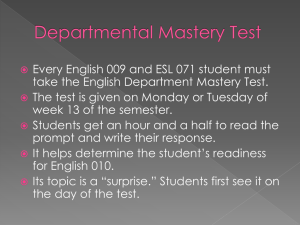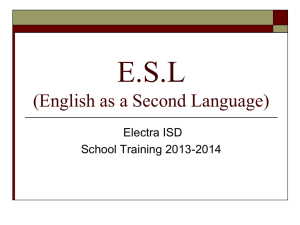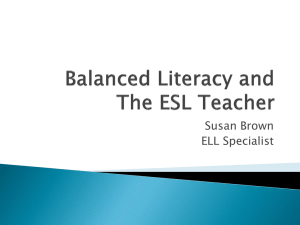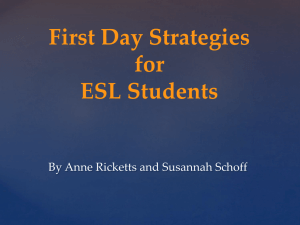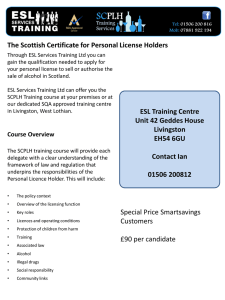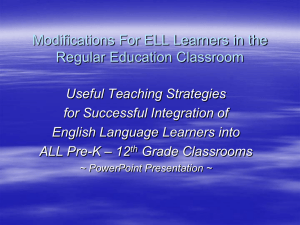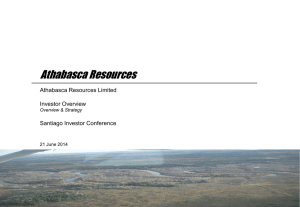Use of Mobile Learning to Train English as a
advertisement
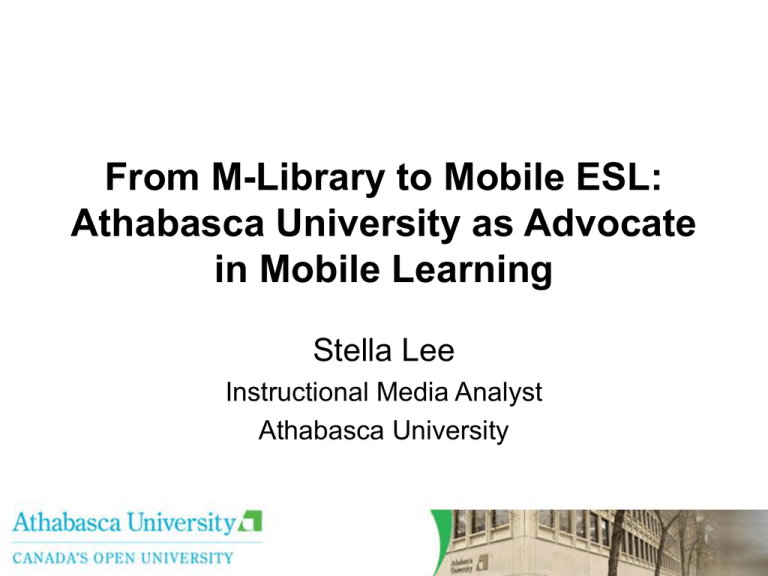
From M-Library to Mobile ESL: Athabasca University as Advocate in Mobile Learning Stella Lee Instructional Media Analyst Athabasca University Today’s Presentation • • • • • Introduction – Athabasca University Why use M-learning Two case studies – M-library, Mobile ESL Challenges and opportunities Questions and Discussions About Athabasca University • Canada’s Open University - distance learning and online learning • Location: Athabasca, Alberta, Canada • Learning centres in Edmonton and Calgary • More than 32,000 students • Individualized and self-paced studies Mission Statement “Athabasca University is dedicated to the removal of barriers that restrict access to, and success in, university-level studies and to increasing equality of educational opportunity for adult learners worldwide.” http://www.athabascau.ca/ Why Use Mobile Technology in AU? • • • • Accessibility of audience Instant delivery and updates Affordablility/portablility Novelty of gadget/display Student Profile • Average age 29 • Two-thirds women • 60% of our program students were employed full-time while studying • 36% undergraduates were visiting students Two Case Studies at Athabasca • M-Library: Mobile Digital Reading Room Initiative • Mobile ESL: learning English as a Second Language Lessons for newcomers M-Library: Mobile Digital Reading Room What is a Mobile Library? • The idea of a mobile library is to provide learners with access to the university library and to course resources using mobile devices Why a Mobile Library at AU? • AU students study from a distance • Quick and efficient access to electronic resources and library services is essential • Students have even more options for fitting learning into their busy lives. It allows individualization & self-pace learning • Supports those with special needs Special Features • Mobile friendly AU Library site: Supported device: PDA, Palmtop, Blackberry, IPAQ, Smart phones • The site include mobile friendly: – Digital Reading Room – Digital Reference Centre – Digital Thesis & Project Room – Library catalogue – Search engine Special Features (ctd) • • • • • • • Auto-detect and reformat Learning object reuse Easy web maintain/update Podcasting Wireless library catalogue Federated search Mobile content conversion on the fly Design/Technology Challenges and Opportunities • Defining content for the M-library – Define the amount and type of information • Design of the format – Normal website vs. mobile version – text, images, graphics, tables, location • Separate the content from the format • Display models – different display model and stylesheet Further Information • Website: http://library.athabascau.ca/drr/ http://library.athabascau.ca/ Mobile ESL Project Overview of Project • Build on success of M-library project • Develop and test innovative approaches to ESL learning using mobile devices to deliver lessons and allowing practice with feedback using a variety of testing methods Subjects Involved in Study The subjects involved were adult learners registered in ESL programs at: • Edmonton Mennonite Centre for Newcomers • Global Community College • Evangelical Chinese Baptist Church Mobile Devices Used • Mobile phones with wireless capabilities (Samsung D807x ) • Desktop access support Content for Project • The content is based on two of the best selling Penguin “Introductory English Grammar and Exercise” books • Consists of 86 lessons and related interactive exercises • Repurpose for Canadian context • Downloadable in Word doc & Acrobat pdf format Evaluation Methods • The students learn the content of the lesson followed by difference practice exercises and testing techniques. • The testing techniques used were multiple-choice, jumbled-sentence, truefalse, and matching Results . . . Student Preference for Question Types Student opinion poll about whether a question type is suitable for mobile devices True/False, 93% Multiple Choice, 75% Word Ordering, 47% Matching, 18% Multiple Choice True/False Matching Word Ordering Pre-test vs. Post-test vs. Retention Test scores A Comparison of the Pre-test (1), Post-test (2), and Retention Test (3) 20 18 16 14 12 10 8 6 4 2 0 1 2 Tests 3 Flexibility of Learning The technology provides flexibility for m e to learn anyw here and at anytim e 4% 0% 4% 2% 34% Strongly Agree Agree Neutral Disagree Strongly Disagree No Response 56% Take Other Lessons Using Mobile Devices I would like to take other lessons using mobile technology 6% 0% 15% 13% Strongly Agree Agree Neutral Disagree 21% Strongly Disagree No Response 45% Student Feedback in General • Reported positive experience with the ESL grammar course and the use of mobile technology in learning ESL grammar • Liked the flexibility of anytime availability of the ESL materials Student Feedback in General • Students indicated that the use of mobile technology for ESL would be a good supplementary medium of learning such as when waiting for an appointment or being on the bus or whenever and wherever there is some spare time • One concern expressed was the cost of Internet access Suggestions for Future Delivery • Use text-to-speech technology to improve the learning experience • More examples to help students understand the questions better • Use the mobile device to interact with teachers • Larger screen size for ease of reading Further information • Website: http://eslau.ca Questions and Discussions • Contact: stellal@athbascau.ca Thank you!

